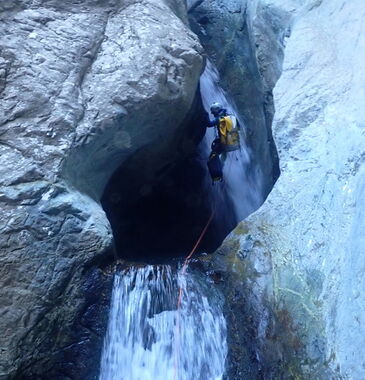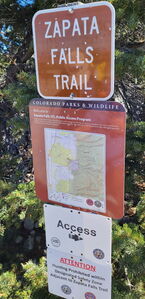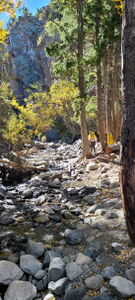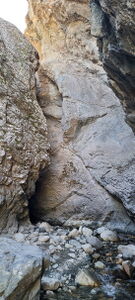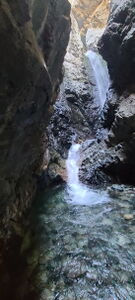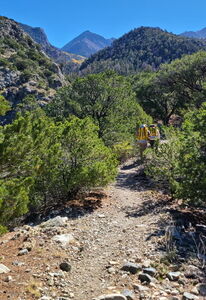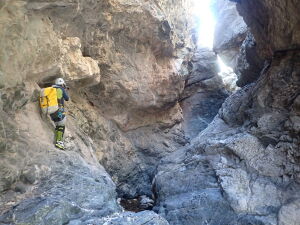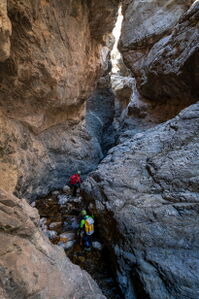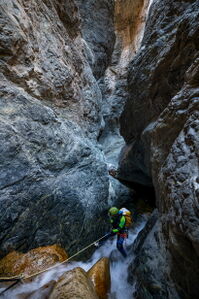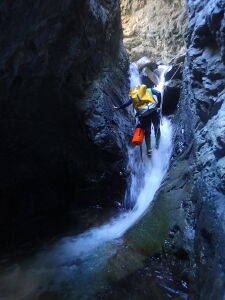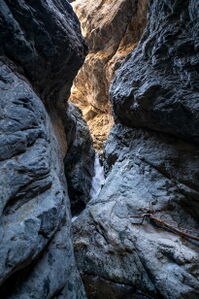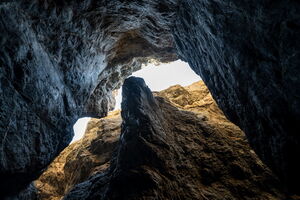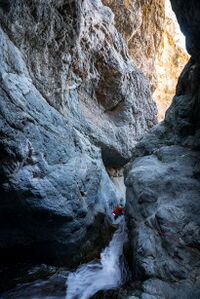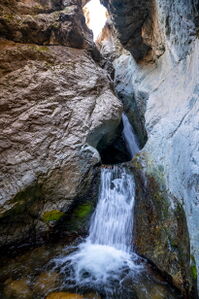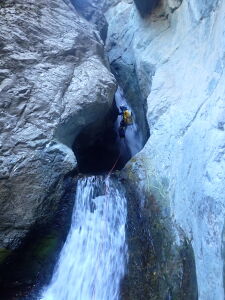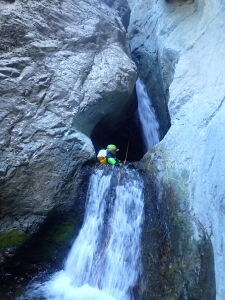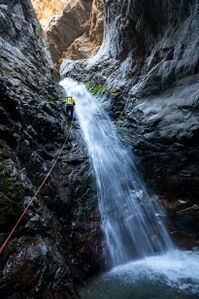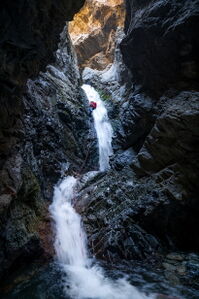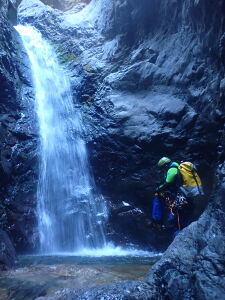Zapata Creek Gorge
| Rating: | |||||||||||||||||||||||||||||||
|---|---|---|---|---|---|---|---|---|---|---|---|---|---|---|---|---|---|---|---|---|---|---|---|---|---|---|---|---|---|---|---|
| | Raps:2-3, max ↨90ft
Red Tape:Permit required Shuttle:None Vehicle:Passenger Rock type:Gneiss | ||||||||||||||||||||||||||||||
| Start: | |||||||||||||||||||||||||||||||
| Parking: | |||||||||||||||||||||||||||||||
| Condition Reports: | |||||||||||||||||||||||||||||||
| Best season: | BEST in Oct
|
||||||||||||||||||||||||||||||
| Regions: | |||||||||||||||||||||||||||||||
Introduction[edit]
Zapata Creek Gorge is a unique and fantastic, although short, deep cold slot canyon near Great Sand Dunes National Park.
October is advised for a descent to avoid the Black Swift nesting season and for those seeking moderate water flow.
Zapata Falls is a popular waterfall hike and visitors can easily hike from an established BLM parking lot after driving up a recently paved road to view the falls from the bottom. A later season (or mid-week) descent will also limit the summer crowds.
Zapata Falls is located within Colorado State Trust Land managed by the BLM. A Hunting or Fishing license is required to hike in Colorado State Trust Land (details in the Red Tape section).
This gorge was formed by glacial meltwater in the last ice age, which cut a notch in a weakness at the edge of the Rio Grande Rift, a giant crack which allowed the Sangre de Cristo Mountains to rise and the San Luis Valley to sink.
The geology map identifies Zapata Falls at the edge of Paleoproterozoic Mixed Gneiss and mixed glacial moraine. This is one of the best carved canyons in the state.
This waterfall is a confirmed nesting site for the Black Swift, listed as a Species of Special Concern by the U.S. Forest Service and U.S. Fish and Wildlife Service. The swifts migrate from Brazil annually to occupy this site from late May until late September, raising a single chick. The swifts are susceptible to disturbance from human activities near their nests, including noise and movement, direct disturbance or destruction of their nests, and trampling of vegetation. Canyoneering/climbing at this waterfall during the Black Swift nesting season (late May - late September/first frost) is likely to cause direct damage to nests, eggs, and young, and disturb adult swifts enough to cause them to abandon their nest and offspring. Click here for more information on the Black Swift.
Approach[edit]
South of the Great Sand Dunes National Park, Drive up the newly (2023) paved Zapata Falls Road to a dirt parking lot off CO 150.
Hike up the well worn and marked trail to the base of Zapata Falls and verify the water flow. Return a short distance and take the trail heading West uphill just before the bottom gorge view.
Continue up the trail to a worn social trail split at (37.61766, -105.55208), downclimb the slope to South Zapata Creek to access the start of the gorge. South Zapata Creek upstream of this point is choked with downed trees and thick vegetation.
Descent[edit]
R1: 25' (or DC) slinging one of the abundant rocks in the canyon. This shallower chute may be downclimbed into the waist deep pool below.
R2: 90' from bolts tucked around the corner on Canyon Right above the first chute, which ends in a waist deep or swimming pothole before a final 15' drop into a shallow pool. Despite rounding the corner, this was an easy pull against the smooth rock.
R3: 80' or 40' Set a natural anchor at the bottom of R2 and use this to either:
- rappel 80' to the bottom of the pool below Zapata Falls or
- rappel 40' latterly as a traverse line to ice climber bolts reachable on Canyon Right, then rappel 40' to the bottom of Zapata Falls
Consider a 10' longer pull rope to be able to pull from the opposite side of the lowest pool.
Downclimb the final 10' to the viewing location for most hikers
Exit[edit]
Walk down the trail back to the parking lot.
Red tape[edit]
Zapata Falls is located on Colorado State Trust Land actively managed by the Bureau of Land Management (BLM). 2.8 million acres of trust land in Colorado earns revenue for public schools and is leased for agriculture and recreation through the Colorado Parks and Wildlife (CPW) Hunting and Fishing Access Program (HFAP). Colorado State Trust Land receives funding from an active Hunting or Fishing licenses.
Hiking to Zapata Falls from the bottom is signed for trail access without requiring a license. However, it is advised that any non-trail activity on Colorado State Trust Land is done with an active Hunting or Fishing License to be compliant.
References:
- https://cpw.state.co.us/placestogo/Pages/StateTrustLands.aspx
- https://slb.colorado.gov/public-access
Purchase a Hunting or Fishing License (even if not hunting or fishing) online at: CPWShop https://www.cpwshop.com/purchaseprivilege.page or by phone (1-800-244-5613).
- Colorado Resident 1 day hunting or fishing licenses are $15.55 (2023 price)
- "State Wilderness Area (SWA) passes may not be used to access State Trust Lands (STLs) leased by the Division, due to current leasing agreements between CPW and the State Land Board." (https://cpw.state.co.us/Documents/LandWater/SWA/License-Requirements-SWA-STL-Access-FAQ.pdf)
Avoid Black Swift Nesting Season (early June - early Sept / first frost)
BLM calls out that the Black Swift has been seen in this area. (https://www.blm.gov/visit/zapata-falls-campground)
The City of Ouray comments on birders visiting Box Cañon Falls to see this rare declining bird population, which migrates to/from Brazil annually and nests in Colorado waterfalls starting in early June through early September around the first frost and when the chicks are mature enough to make the migratory flight south. (https://cityofouray.com/city_offices/city_resources/black_swifts.php)
Therefore descending Zapata Falls is called out here as best in the narrow window of early October for several reasons: avoiding Black Swift nesting, reduction in water levels and reduction in waterfall-viewing visitor crowds. Luckily the San Luis Valley is warmer than other parts of Colorado with abundant sunshine to counter the dark short slot and chilly high mountain water.
Beta sites[edit]
Ice Climbing: https://www.summitpost.org/zapata-falls-wi2-3/702658
Trip reports and media[edit]
24 Aug 2016 First known descent by Wayne Herrick and Logan DeGrand. Rated as 4 C3 II R - The Class 4 rating due to anchor building requirement in the watercourse. The R rating for a 2-tier rappel [R2] through a curved hallway with no way to see or hear the rappeller.
6 Oct 2023 kml map and details added after a descent by Ira Lewis, Andrew Tanasescu and Kati Wright. Rated as 3 C1 I = v3 a4 III. The R rating was removed as not needed in the lower water flow. October recommend for the descent in the page ratings.
Background[edit]
"Zapata Falls is a waterfall located near the base of the Sangre de Cristo Mountains on Bureau of Land Management land adjacent to Rio Grande National Forest and south of Great Sand Dunes National Park. The falls has a drop of 30-foot (9.1 m). Access to this waterfall entails a mildly steep 0.5 mi (0.80 km) hike. Viewing the falls requires fording the stream and climbing rocks. Black swifts nest near the falls, one of the few known breeding sites for this species in Colorado During the summer months, the falls provide a cooling oasis, but during the winter months, the waterfall freezes into an enormous column of ice, perfect for the experienced ice climber." (https://www.blm.gov/visit/zapata-falls-srma)
